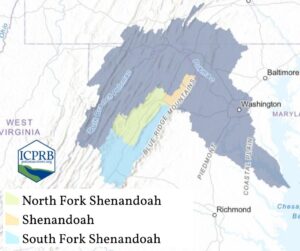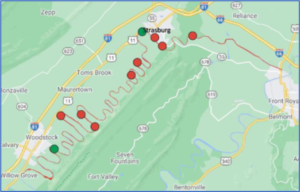Shenandoah River
Interstate Commission on the Potomac River Basin
Traversing the Great Valley
 The North Fork and the South Fork of the Shenandoah converge near Front Royal, Va. The mainstem of the river then converges with the Potomac River at Harper’s Ferry, WV. The watershed is noted for its limestone underlay and karst topography. The river is a major source of drinking water for many communities in the region.
The North Fork and the South Fork of the Shenandoah converge near Front Royal, Va. The mainstem of the river then converges with the Potomac River at Harper’s Ferry, WV. The watershed is noted for its limestone underlay and karst topography. The river is a major source of drinking water for many communities in the region.
The following reports are work that ICPRB staff has done in the Shenandoah region.
ICPRB Work in the Shenandoah Watershed
Hurricane Ida Scours Shenandoah River Harmful Algal Bloom in 2021
Virginia Department of Health issued a Harmful Algae Bloom (HAB) Advisory for a 53-mile stretch of the North Fork of the Shenandoah River on August 10, 2021. Samples from algal mats on the river bottom contained harmful levels of toxins produced by cyanobacteria. Three weeks later, Tropical Storm Ida passed over the North Fork, dumping torrential rain on the watershed. Sharply rising streamflows scoured the benthic algal mats and washed them and their toxins downstream.

53-mile reach of North Fork Shenandoah River with high cyanotoxin levels in bottom algal mats, August 2021 (from Virginia Department of Health).
ICPRB’s Emergency River Spill Model (ERSM) indicated the leading edge of the scoured material would reach the Potomac River mainstem in 1 – 2 days and eventually reach Washington, D. C., passing several drinking water intakes along the way.
Water samples collected by ICPRB at the mouth of the Shenandoah indicate the tropical storm’s extremely high flows, however, had diluted the scoured algal cells and their associated toxins to low, undetectable levels. Dilution was the solution to the pollution problem in this case. At slower river flows, detectable levels of toxin may have made it further downstream.
Rapid Response Survey of Cyanobacteria Toxin Levels Downstream of North Fork Shenandoah River Algal Bloom After Tropical Storm Ida, 2021 (ICPRB Report 21-4).
Other Studies in the Shenandoah Region
- West Virginia Algae Surveys, 2012-2018
- Biological Surveys of Three Potomac River Mainstem Reaches (2012-2014) with Considerations for Large River Sampling
Return to Aquatic Life Main Page
